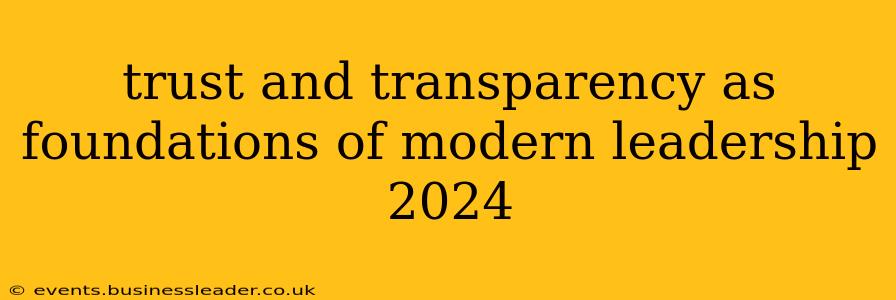In today's rapidly evolving world, effective leadership hinges on two crucial pillars: trust and transparency. These aren't just buzzwords; they're essential ingredients for building strong teams, fostering innovation, and navigating complex challenges. 2024 demands leaders who prioritize these values, not just for ethical reasons, but for achieving tangible business success. This article will explore how trust and transparency are foundational to modern leadership, addressing common questions and offering practical strategies for cultivating them within organizations.
What is the importance of trust and transparency in modern leadership?
Trust and transparency are intrinsically linked. Transparency—the open sharing of information—builds trust by demonstrating honesty, integrity, and respect for team members. When employees feel informed and valued, they're more likely to trust their leaders and the organization as a whole. This fosters a culture of psychological safety, encouraging open communication, collaboration, and ultimately, better decision-making. In the absence of trust, even the best-laid plans can falter due to internal conflict, suspicion, and a lack of buy-in. This is particularly crucial in 2024, a year characterized by ongoing economic uncertainty and rapid technological advancements, both of which require agile and collaborative responses.
How do trust and transparency impact employee engagement and productivity?
A transparent and trustworthy leadership style directly impacts employee engagement and productivity. When employees understand the "why" behind decisions and feel their voices are heard, they are more motivated and committed to their work. This translates to increased productivity, reduced employee turnover, and improved overall morale. Conversely, a lack of transparency can lead to cynicism, disengagement, and decreased productivity. Employees may feel undervalued, leading to a lack of motivation and a potential exodus of talent. In 2024's competitive job market, retaining skilled employees is crucial, and trust and transparency are key to achieving this.
How can leaders build trust and transparency within their teams?
Building trust and transparency requires consistent effort and a genuine commitment from leaders. This involves:
- Open Communication: Regular, honest communication is paramount. Leaders should proactively share information, both good and bad, and encourage open dialogue. This includes actively soliciting feedback and addressing concerns promptly.
- Accountability: Leaders must be held accountable for their actions and decisions. This demonstrates integrity and builds trust. Acknowledging mistakes and taking responsibility fosters a culture where mistakes are seen as learning opportunities rather than sources of blame.
- Empowerment: Empowering employees by giving them autonomy and responsibility fosters trust. When employees feel trusted and valued, they are more likely to reciprocate that trust.
- Leading by Example: Leaders must model the behavior they expect from their teams. If leaders are transparent and trustworthy, it sets the tone for the entire organization.
- Active Listening: Truly listening to employees' concerns and ideas demonstrates respect and builds trust. Leaders should create safe spaces for open dialogue and feedback, ensuring that all voices are heard.
What are some common barriers to trust and transparency in the workplace?
Despite its importance, building trust and transparency isn't always easy. Common barriers include:
- Fear of negative consequences: Leaders might withhold information fearing criticism or negative repercussions.
- Lack of communication skills: Inability to communicate effectively can hinder transparent interactions.
- Organizational silos: Information may be compartmentalized, making it difficult to achieve transparency.
- Micromanagement: Excessive control can stifle trust and autonomy.
- Lack of psychological safety: Employees may fear retribution for speaking up.
How can organizations foster a culture of trust and transparency?
Cultivating a culture of trust and transparency is an ongoing process that requires a holistic approach. It involves:
- Establishing clear communication channels: This ensures information flows freely throughout the organization.
- Regular feedback mechanisms: Implementing systems for regular feedback helps identify areas for improvement.
- Training programs: Investing in leadership development programs can enhance communication and trust-building skills.
- Promoting a culture of open dialogue: Creating safe spaces for employees to voice their opinions and concerns.
- Celebrating successes and learning from failures: This fosters a culture of shared responsibility and mutual respect.
In conclusion, trust and transparency are not merely desirable qualities for modern leaders; they are essential prerequisites for success in 2024 and beyond. By prioritizing these values, leaders can build high-performing teams, foster innovation, and navigate the complex challenges of the modern business landscape. The benefits extend beyond improved morale and productivity, ultimately shaping organizations that are more resilient, adaptable, and ethically sound.
